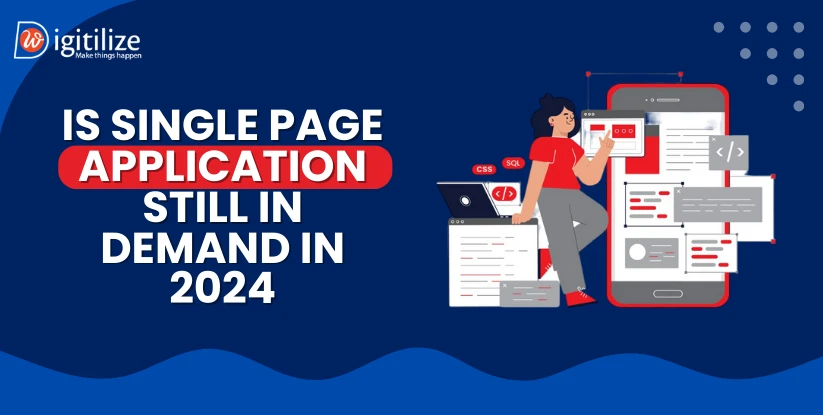Is Single Page Application still in demand in 2024

Is the SPA model still relevant in 2024? 5.19 billion people utilise the internet globally, accounting for more than 64% of the total population. Thus, creating online apps and web solutions in particular is a good idea because there will undoubtedly be a large number of potential users. But the question is simple page application still in demand in 2024?
Yes! In order to provide such amazing and previously unheard-of functionalities, the digital world underwent several adjustments. Single-page application development services are one such revolutionary and game-changing advancement in web development.
These days, single-page apps are an essential component of the current JavaScript architecture. These apps provide users with an incredible user experience, quicker performance, and no page refresh, making them nothing short of marvels. This blog will analyse the top Single Page Applications UK frameworks and provide an in-depth review of their benefits, features, and current market trends.
What is a single-page application?
Applications that let users interact with web pages in a new way are single-page apps. These programmes operate within a browser, doing away with the requirement to refresh pages while using them. A SPA trends 2024 is a single webpage that users browse and that loads extra content using JavaScript. When a SPA offers pages directly within the browser, it performs separate requests for the data and markup.High-level JavaScript tools like Knockout.js, Meteor.js, Ember.js, and AngularJS make this approach possible. Material is offers to customers in a seamless, user-friendly online environment thanks to SPAs. Creating a natural atmosphere is the primary goal of SPAs in order to provide an amazing and engaging user experience.
This leads us to conclude that with SPAs, only a limits quantity of data has to be updates at a time. The client-side execution of presentation logic updates freshly requests data in the background, maintaining the visual structure of the online application.
How Single-page app benefit business?

Single-page apps are the most appropriate option for your company’s needs if you also intend to create a website with an extensive feature set. Online businesses may anticipate several more benefits by including the Single Page App strategy in the design of their web experiences.
-
Increased Reactivity
-
Improved Qualities
-
Navigation Made Easier and Simpler
-
Improved User Experience
-
Offline Support and Cache
-
Linear UX
-
Simple Debugging
Top features of Single-page apps

-
Rendering on the client side
-
Serve-side graphics
-
Considering Search Engine Optimisation
Top Single-page app tools

-
React JavaScript
-
Vue.js
-
EmberJS
Single-page app vs. Multiple-page apps

In the field of web development, single-page and multi-page applications are two crucial paradigms. The most contentious issues include which model is superior to the other, how these two apps differ from one another, which application development is more advantageous, etc. Selecting the best model will be made much easier by being aware of the differences between these two.
Single-page apps
Pros
- When a user navigates the programme more swiftly, pages load more quickly, improving the user experience.
- It takes less time to design and develop than standard MPAs.
- Since this technology is still in its infancy, many of the problems related to SPAs are being fixed.
- Mobile apps that enable code reusability down to the UI components can be created using SPA frameworks.
Cons
- JavaScript must be enabled for SPAs to function.
- JavaScript memory leaks can cause a decrease in productivity.
- Since there are more files created and two states that must be maintained between the SPA and the RESTful API, enterprise apps might be more difficult to build and manage as SPAs.
- Due of the increased strain on the mobile browser, SPA Development 2024 have the potential to deplete battery life more quickly than MPAs.
- Debugging SPAs requires more work and expertise. This is because, instead of using IDEs, developers must utilise the integrated development tools (IDEs) provided by their browsers.
Multiple-page apps
Pros
- Typically, the first page loads more quickly than the first-page load of a React SPAs.
- MPAs are ideal for users that need reliable navigational indications. Since MPAs are typically generated through multi-level menus, this is the reason for their usage.
- When creating monolithic apps with a single state section, MPAs are a more straightforward choice.
- The developer IDEs come with a number of well-liked debugging tools that support MPAs.
- Because MPAs demand more advanced technology, their construction is often less expensive.
- Since most search engine crawlers were designes with MPAs in mind, SEO is simpler and more efficient.
Cons
- All other pages load slowly as well, because the server has to request data and generate the user interface.
- The development process takes longer when mobile applications don’t reuse all of their code.
FAQ
Frequently Asked Questions
The user experience (UX) of single-page apps is improved since users may move between the application's several pages quickly and without having to wait for them to refresh. Additionally, developing a single-page app is less expensive than developing a regular app.
Single-page application design ensures that the page never refreshes, providing an amazing user experience and saving users a tonne of time. Customers won't even realise that these applications are websites since they are so quick and simple to navigate with the scroll function.
Because single-page apps rely more on client-side scripting than multi-page apps, they are more susceptible to cross-site scripting (XSS) attacks.
Because they download all of the data at once and don't need to refresh when the user requests additional data, single-page applications are quicker.
When developing an application for dynamic platforms with fewer data, single-page app development (SPA) is a great choice since it offers a number of benefits. Future mobile applications will be built on single-page apps.
It's true that one-page applications can benefit from SEO. However, in order to organise and construct an SEO-optimised SPA, developers must possess sufficient expertise and competence.

